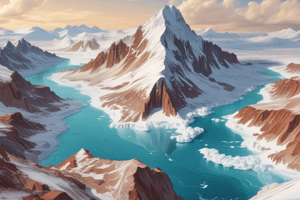Podcast
Questions and Answers
What is expected to happen to the price difference between fossil fuels and renewable energy sources in the future?
What is expected to happen to the price difference between fossil fuels and renewable energy sources in the future?
- It will decrease
- It will remain the same
- It will disappear
- It will widen further (correct)
What is one benefit of transitioning to renewable energy besides reducing our reliance on fossil fuels?
What is one benefit of transitioning to renewable energy besides reducing our reliance on fossil fuels?
- It reduces GDP
- It makes our air better (correct)
- It is more expensive
- It increases CO2 trends
What is a positive trend observed in GDP and CO2 trends?
What is a positive trend observed in GDP and CO2 trends?
- They are directly correlated
- They are unrelated
- They are inversely correlated
- They are decoupled (correct)
How can sustainability be viewed?
How can sustainability be viewed?
What is the purpose of Qunli Stormwater Park in Haerbin City, China?
What is the purpose of Qunli Stormwater Park in Haerbin City, China?
What is a key feature of Qunli Stormwater Park?
What is a key feature of Qunli Stormwater Park?
What is a benefit of the rapid transition to renewable energy and electrification?
What is a benefit of the rapid transition to renewable energy and electrification?
What is the significance of Nimes and Leuven in the context of sustainability?
What is the significance of Nimes and Leuven in the context of sustainability?
What is the outcome of decoupling GDP trends from CO2 trends?
What is the outcome of decoupling GDP trends from CO2 trends?
What is the purpose of highlighting the price difference between fossil fuels and renewable energy sources?
What is the purpose of highlighting the price difference between fossil fuels and renewable energy sources?
Flashcards are hidden until you start studying
Study Notes
Glacials and Interglacials
- Glacials and Interglacials have large temperature variations, with the Antarctic record showing variations of over 12°C over the last million years.
- The last interglacial maximum had no Arctic sea ice, high sea levels, and small ice caps.
CO2 Variations
- Atmospheric CO2 concentration has varied, with a 2019 average of 411.
- Human activities, such as fossil fuel use and cement production, have contributed to CO2 increase, but only 48% of emissions are due to these activities.
Evidence of Warming
- Decrease in 13C/12C ratios indicates carbon from fossil fuels, which has a 2% lower ratio than natural carbon.
- The greenhouse effect has been known since the 1850s, with contributions from Eunice Foote and John Tyndall.
- Radiative forcing affects Earth's radiative balance, leading to warming or cooling.
- IPCC Assessment Reports have consistently provided evidence of climate change and its impacts.
Climate Change Impacts
- Risks and impacts increase with global mean warming, affecting systems with restricted geographic ranges, biodiversity, and human populations.
- Examples of impacts include heat waves, drought, and coastal flooding.
Global Governance
- The UNFCCC and Paris Agreement have set goals for climate mitigation, with the IPCC providing scientific basis for these targets.
- Global governance is necessary to address climate change.
Reducing Carbon Footprint
- Individuals can reduce their carbon footprint by switching to renewable energy, insulating homes, and reducing energy use.
- Reducing meat consumption and food waste can also help, as food production accounts for 25% of global GHG emissions.
- Consider planet-friendly investments and support the transition to a climate-neutral economy.
Sea Level Rise
- Sea level rise is primarily driven by ocean warming and glacier melting.
- If the target is not reached, sea level rise could be 25 cm to 1 m, putting 800 million people at risk.
Climate Anxiety and Transition
- Climate anxiety is a real concern, with many young people feeling hopeless about the future.
- However, the transition to a climate-neutral economy has begun, with renewable energy prices decreasing rapidly.
- The era of fossil fuels is ending, and electrification is becoming a viable solution.
Studying That Suits You
Use AI to generate personalized quizzes and flashcards to suit your learning preferences.




